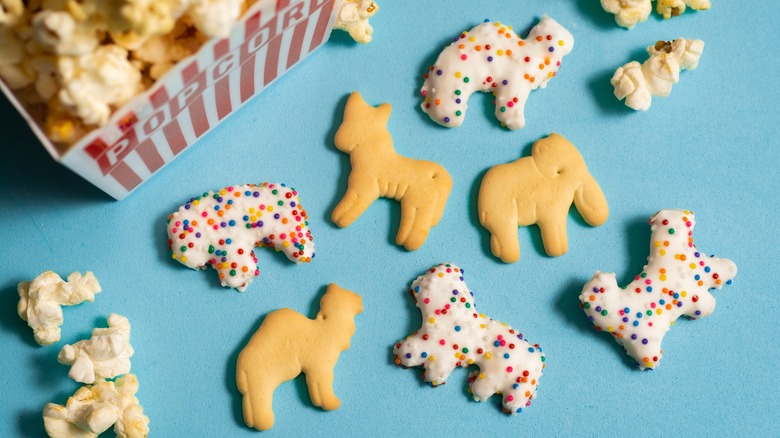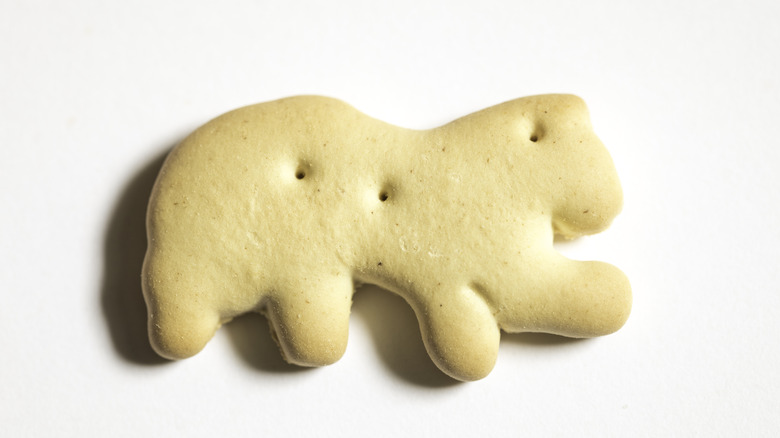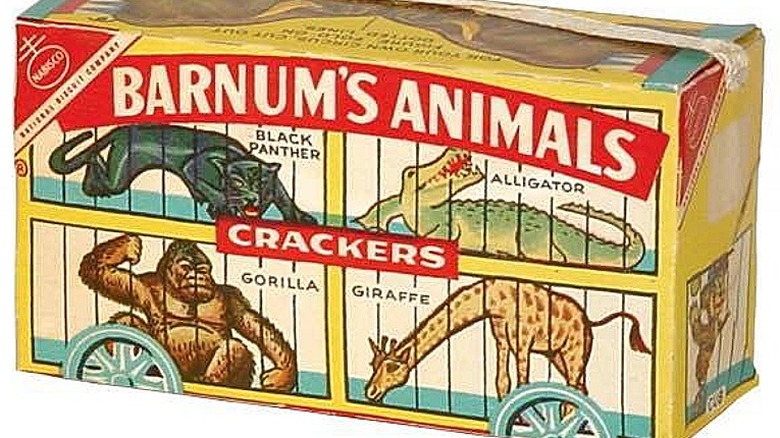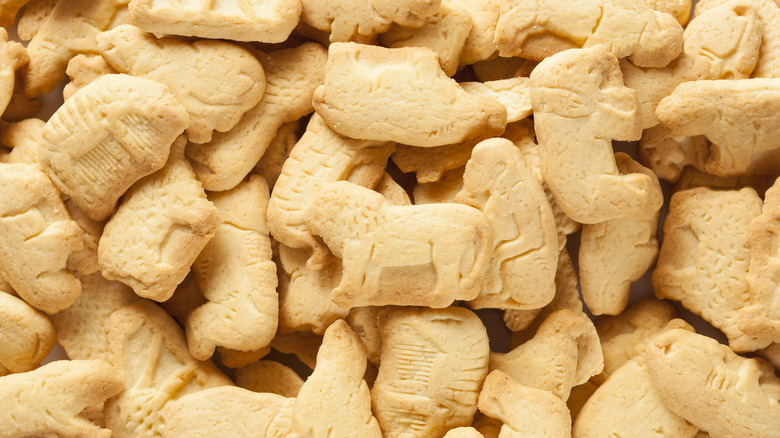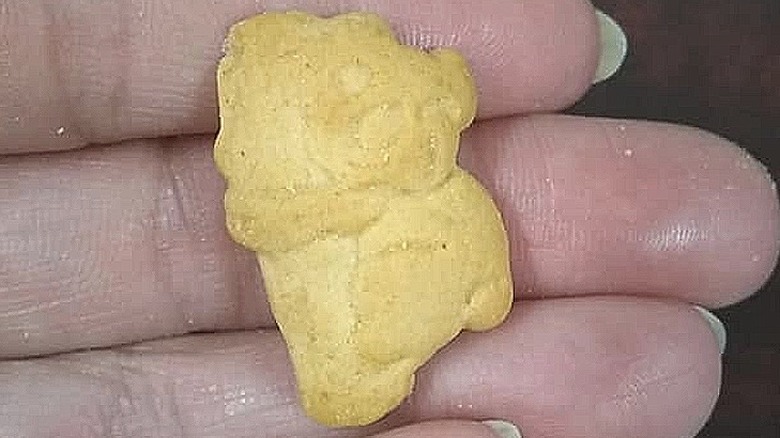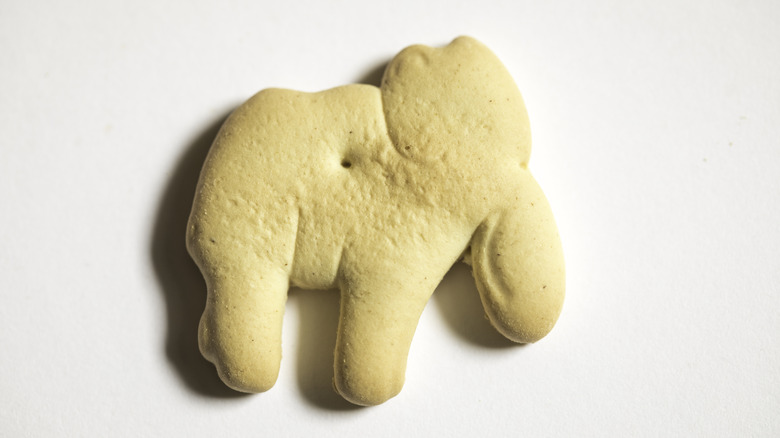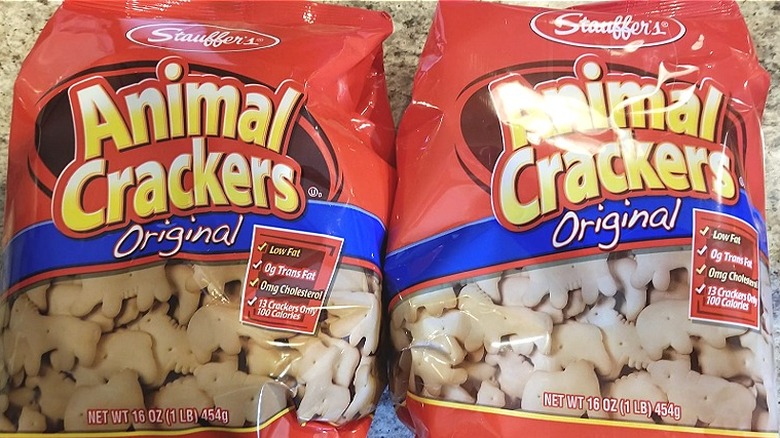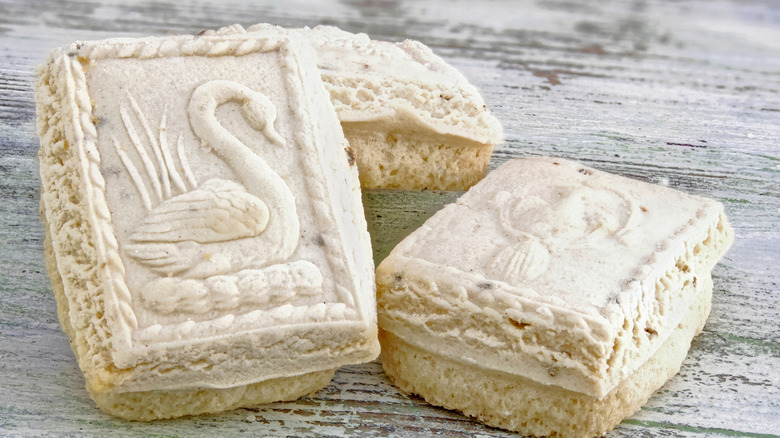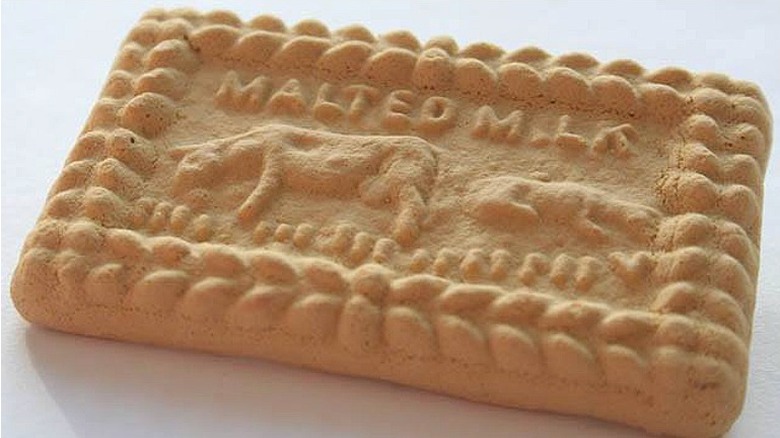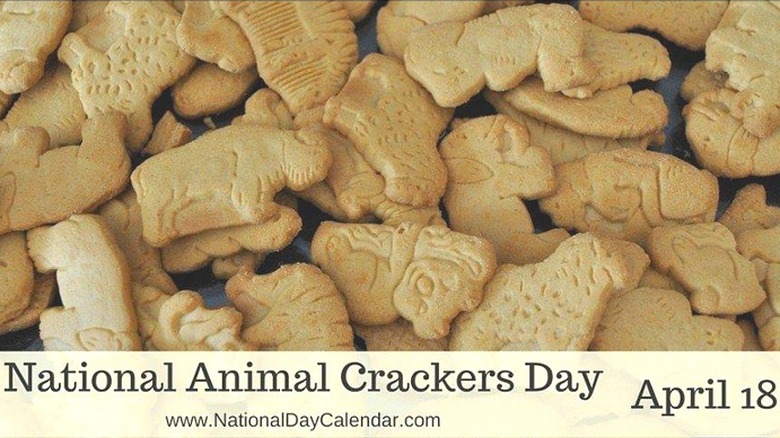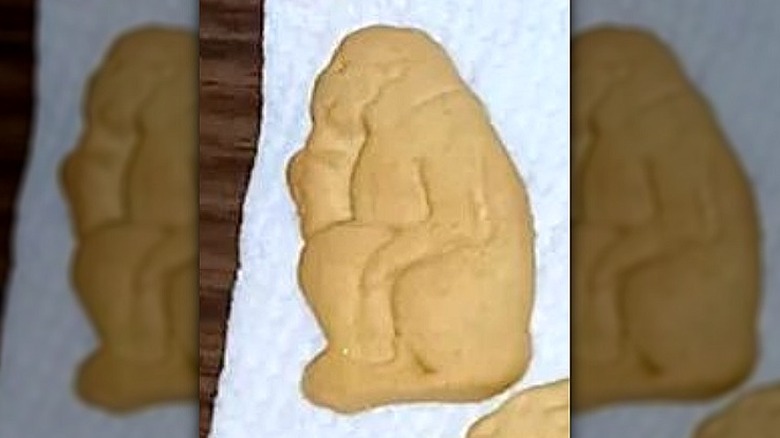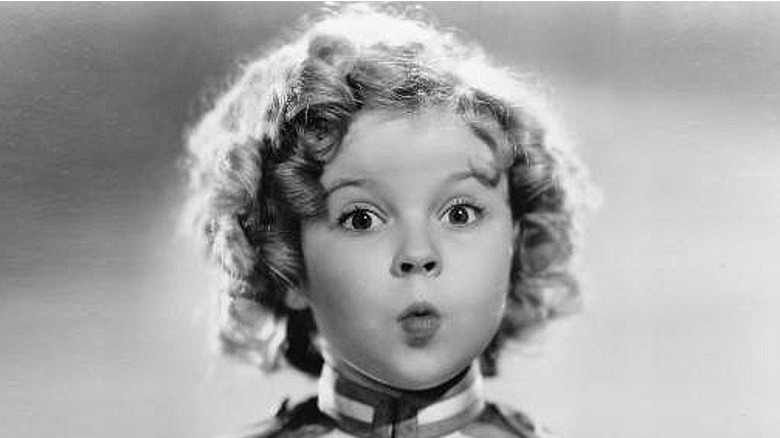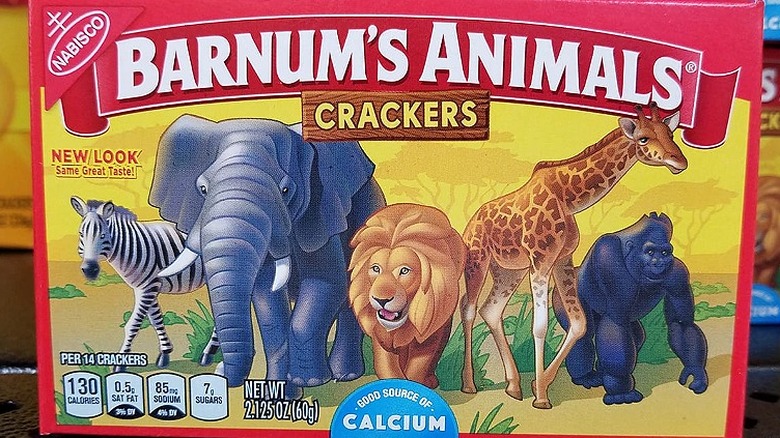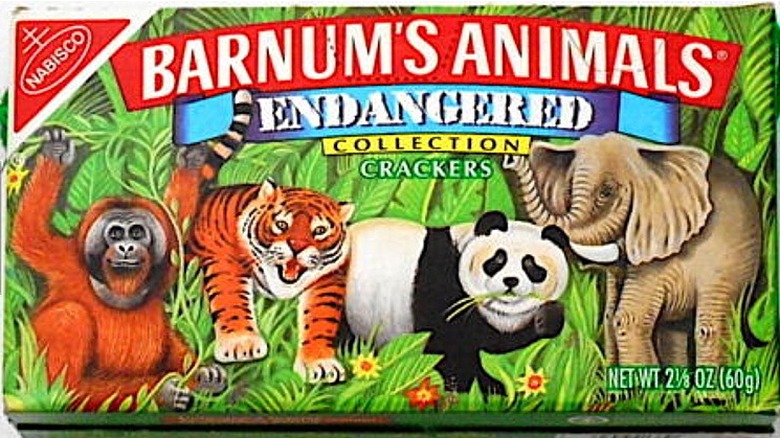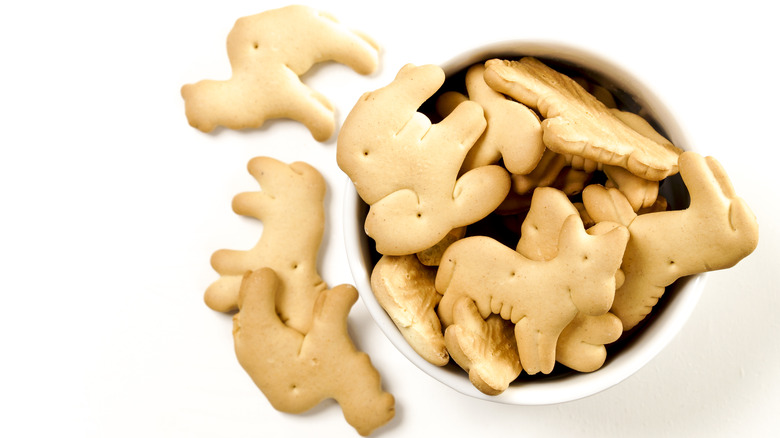16 Things You Didn't Know About Animal Crackers
We may receive a commission on purchases made from links.
For over a century, children have grown up with the idea of seeing animals at the zoo or the circus stoking their imaginations. Ethical considerations aside, the only time kids would come face to face with an elephant, a lion, or a giraffe was in these contexts, and it was a thrilling experience. Their imaginations could follow them home along with a box of animal crackers, which were carefully organized by animal and strategically eaten one by one, sometimes head first.
They were a delicious and fun snack that became a part of our daily lives and foundational memories of childhood. Regardless of which brand of animal cracker you recall eating, chances are you have continued the legacy of feeding them to your children. But did you know that the animal cracker has a rich and fascinating history punctuated by ingenuity and a commitment to evolving with the times? You may find some answers to lingering questions about these beloved treats you never realized you had.
They're a cookie-cracker hybrid
While they are called animal "crackers," these sweet delights have a flavor and ingredients that are more reminiscent of a cookie than a savory cracker. Historically crackers are divided into three categories, soda, graham, and sprayed, which contain sugar but are appropriate in both sweet and savory applications. The cookie has a less specifically defined set of criteria, characterized as a tiny, flat cake made using flour, sugar, eggs, and fat, but may contain a myriad of other ingredients. When it comes to animal crackers, Stauffer's and Nabisco engender fierce loyalty, with Stauffer's adhering to more of a classic English biscuit-like layered product and Nabisco sticking with a sweeter, cookie-like iteration.
Therefore, animal crackers could fit into both categories, but they contain one defining distinction more characteristic of a classic cracker than a cookie — "docking." Docking is a process by which tiny holes get punched into the cracker dough before baking. These holes enable the cracker to puff up and fill with air without exploding, creating the ideal layering of texture to make them crunchy instead of crumbly. These docks are also crucial to a cracker maintaining its shape, which in the case of an animal cracker is even more necessary. Indeed, the animal cracker would be more of an amorphous mass instead of the delightful little animals we love to munch on without those tiny holes.
They've been called Barnum's Animals since 1902
While there are numerous manufacturers of animal crackers throughout the U.S., arguably the most well-known is Nabisco's Barnum's Animal Crackers. These crackers made their debut in 1902, when the National Biscuit Company, as Nabisco was formerly known, decided to capitalize on the popularity of the Barnum and Bailey Circus by designing cookies inspired by old-fashioned circus train cars filled with animals. When they first appeared, they were called "Barnum's Animals." They didn't obtain their current name, "Barnum's Animal Crackers," until 1948. Whatever you call them, consumers have been smitten with animal crackers ever since. According to Reader's Digest, the industry sells over 40 million packages annually in 17 distinct countries, with Nabisco leading the pack.
And while these crackers are an homage to Barnum and Bailey Circus, which eventually became the Ringling Bros. and Barnum & Bailey Circus company, even today, Nabisco doesn't pay the corporation any royalties for using the name "Barnum." This fact is partly because of how far back that name goes, predating the circus itself, and partly because it refers to P.T. Barnum himself rather than the circus.
The string was originally for ornamental use
The first iteration of animal crackers sold in bulk-size tins or barrels is the origin of the term "cracker barrel." However, during the Christmas season of 1902, Nabisco introduced the now legendary individual-sized red train car boxes with a string attached to their Barnum's Animal Crackers as a promotional idea for the holiday season. The idea was that once the boxes were empty, children could take the packages and use them as ornaments to hang on their Christmas trees. According to Reader's Digest, these individual-sized containers sold for a whopping 5 cents apiece at the time.
And while they may have been a temporary offering, this packaging stuck and has now become synonymous with the brand. Today the Nabisco factory in Fair Lawn, New Jersey, which manufactures Barnum's Animal Crackers, continues to use string to fashion the handles of their boxes to the tune of over 8,000 miles annually, which would equal approximately the distance from the U.S. to Yemen for the sake of a reference point.
54 different animals have been represented over the years
The possibilities may seem virtually endless for animal varieties depicted in cracker form, and yet there have only been 54 different kinds of animals represented in animal crackers across all brands since their inception. Per South Florida Reporter, Nabisco's Barnum's Animal Crackers have featured 37 unique animals since 1902, with only four existing from the beginning: bears, elephants, lions, and tigers.
The brand's most popular item sold is the two-ounce box, which includes 22 animal crackers in the shape of 19 distinct animals, according to CulinaryLore. The breakdown is as follows: two bears, a bison, a camel, a cougar, an elephant, a giraffe, a gorilla, a hippo, a hyena, a kangaroo, a koala, a lion, a monkey, a rhinoceros, a seal, a sheep, a tiger, and a zebra. There are other package sizes, including one-ounce and multi-pack options, which may vary in which animals they include. The next time you break into a box of Barnum's Animal Crackers, see if you can identify and count all the animals yourself!
The most recent addition is the koala
In 2002, Nabisco set out to create a bit of a media frenzy surrounding its 100th anniversary. The company's creative way of getting the public excited about the brand and the celebration? Create a contest in which a new animal would join the edible menagerie. Nothing excites a crowd like being allowed to have their voices heard by one of their favorite brands.
According to Reader's Digest, after a process of elimination, the vote came down to four iconic creatures: the koala, the penguin, the cobra, and the walrus. When the final votes were tabulated, winning by popular demand — the cuddly koala. While we are slightly surprised that the penguin didn't fare better, we aren't entirely shocked that the slithering cobra or the whiskered walrus didn't land on top. After all, it is hard to compete with a cuddly koala. Our question is, what will the next animal added to Barnum's Animal Crackers box be?
There are more animal crackers out there than you might realize
While Stauffer's and Nabisco's Barnum's Animal Crackers may be the two most recognizable animal crackers, the number of different varieties and brands is staggering and mind-blowing. Stauffer manufactures approximately one million animal crackers daily in plain and chocolate flavors, per the York Daily Record. They also produce an iced version called "animal cookies" and cheddar whales, which are separate entities. Under the Nabisco umbrella, you will find both Barnum's Animal Crackers and Teddy Grahams.
Other strictly animal-themed crackers include Gerber Graduates Cinnamon Graham Animal Crackers, Trader Joe's Organic Animal Crackers, Market Pantry Animal Crackers, Kinni Kritters Gluten-Free Animal Cookies, Austin Zoo Animal Crackers, Annie's Homegrown Bernie's Farm Animal Crackers, Kirkland Organic Animal Crackers, Barbara's Chocolate Chip Snackimals Cookies, Keebler Animal Crackers, Wild Jungle Animal Crackers, Mother's The Original Circus Animal Cookies, and many more. And this doesn't even begin to address things like the Pepperidge Farm Goldfish or any other non-animal-shaped cookie or cracker out there. Children and adults love to snack on crunchy crackers and cookies shaped like animals and seafaring creatures of all kinds, and the trend is here to stay.
They got a new look in 1958
Before 1958, Nabisco manufactured its animal crackers using cookie cutters in the form of animals that would punch out a stamp from the dough to produce the notion of each animal without a lot of fine detail. This process would often lead to consumers trying to guess what animal they were eating. One could easily make out the contours of a cat, but deciphering whether it was a lion or tiger was a bit more challenging.
All of this changed with the introduction of rotary dies. The rotary die is essentially a mechanized cylindrical cutter with the same stamp built into it in succession all the way around. It rotates continuously to produce the same pattern repeatedly. This innovation simplified and sped up the process of creating shaped crackers with far more precision and detail. These die cutters are still used today and are the reason such a variety of animals can be manufactured at once with such intricate features making them instantly identifiable.
Stauffer's Animal Crackers have a unique formula
Animal crackers were introduced to the U.S. by D. F. Stauffer Biscuit Co., located in York, Pennsylvania. In those days, the company primarily produced pretzels, although it was slowly dipping its toes into the cracker and cookie business. The company, now known simply as Stauffer's, has been using the same recipe to make its signature animal crackers since it entered the market. This recipe is more of a classic English-style biscuit that is slightly sweeter and has a pillow-like puffy shape with a texture that doesn't crumble and make a mess. The flavor is less cookie-like than other animal crackers, with strong notes of nutmeg and mace to pump up their earthiness.
Stauffer's animal crackers are not as detailed as some of its competitors, but you can find an animal identifier chart to help you decipher which of the 13 shaped animals you are about to consume. For reference, the brand's "zoo" of animals includes the following: bear, buffalo, camel, cat, cow, donkey, elephant, hippopotamus, horse, lion, mountain goat, rhinoceros, and tiger. Perhaps part of the fun of eating this brand of animal cracker is figuring out on your own whether you are consuming a donkey or a horse, a cat or a tiger.
There were animal crackers in the 17th century
Some of the earliest evidence of the presence of animals on cookies or crackers dates back to the 1600s and the winter celebration of Julfest by Germans. This festival honored Germanic pagan tribes with one of the many traditions involving sacrificing animals in hopes that God would provide a warm winter and an early spring. Most of the population could not afford to slaughter their animals in sacrifice, so an alternative was born.
This alternative was known as the Springerle cookie, roughly translating to "little knight" or "jumping horse" in ancient Germanic dialect. These cookies, made of a basic dough using flour, sugar, eggs, and anise flavor, were round and typically stamped with a scene on the top. These designs, created with hand-carved rolling pins and molds, often depicted animals. Peasants could therefore offer these cookies as a sacrifice instead of real animals, thereby still participating in the ritual without harming any actual animals. These stamps eventually evolved to include other scenes, including Biblical stories, used to educate illiterate Germans about the Bible. Examples of these cookies exist today in Bavaria and Austria, where similarly stamped cookies like Lebkuchen, Spekulatius, Frankfurter Brenten, and Springerle are exchanged at Christmas and other special occasions.
Modern animal crackers came from England
The biscuit, or cookie, is a British tradition born out of the history of British colonialism. Before the mid-1600s, biscuits were hard, dry crackers made to provide sustenance for the military and the poor. Once the British settled islands of the Caribbean and began erecting sugar plantations built on the backs of enslaved people, sugar flowed readily into the British economy. This sugar made its way into biscuits, which became more elaborately flavored and stamped with various intricate designs, including figures like animals.
These biscuits became a staple of the British tradition of high tea, inspiring the imaginations of Americans who became exceedingly fond of the delicate yet firm cookies. By the mid-1800s, according to Reader's Digest, one such variation of a biscuit, known as animal biscuits, became the inspiration for the first recipe produced by Stauffer's in 1871. To this day, Cadbury continues to manufacture an iteration of animal biscuits coated in the brand's legendary milk chocolate.
There's an Animal Crackers Day
Americans are somewhat obsessed with celebrating. Virtually every date on the calendar is devoted to the recognition of one or another aspect of our popular culture. Animal crackers are no different. While there is no clear indication about when we began dedicating an entire day to the legendary animal cracker, we now honor it on April 18th of every year.
Some fun facts about Barnum's Animal Crackers, via EatWheat.org, include that they are baked on an enormous conveyor belt 300 feet long for four minutes per batch, which means they can manufacture 12,000 animal crackers per minute. Additional fun facts note that one bushel of wheat can yield 245 boxes of animal crackers, converting to 5,408 unique samples, which means a single acre of wheat is responsible for 226,380 animal crackers! That's a lot of crackers! If you plan to celebrate National Animal Cracker Day this year, consider doing a side-by-side taste test of different brands to see which recipe you prefer. And don't forget to take the time to identify each animal in your box or package of animal crackers. Knowing which animals are in your edible zoo is part of the fun.
Only one animal cracker wears clothes
We all know animals do not wear clothes, except in cartoons and at Build-a-Bear, and generally, animal crackers follow suit, except for one costumed critter: the monkey. For whatever reason, Nabisco decided to produce its monkey wearing a hat and a pair of pants. The outfit is cute, if not just slightly befuddling. Why is the monkey special? Is there some anthropomorphizing of the monkey occurring?
We are not the only ones to wonder about this. It was the topic of conversation in an episode of "Buffy the Vampire Slayer" that aired in 1998. Oz notes that the monkey is the only one wearing clothes and ponders if the other animals are jealous or feel deprived of their dignity. It's a short but ever-so-thought-provoking scene. While we have our theories about why the monkey has clothes, ranging from depictions of monkeys clothed at circuses to a desire to distinguish the monkey from the gorilla, nobody knows why the monkey has clothes. What are your best guesses? Inquiring minds want to know.
Shirley Temple's animal crackers song is technically wrong
In the 1935 hit movie "Curly Top," a pint-sized Shirley Temple sang about animal crackers in the song "Animal Crackers in My Soup." She famously sings, "monkeys and rabbits loop the loop." There's just one hitch in the giddy-up — rabbits were never a part of the Nabisco menagerie of animal cracker animals. Whoever wrote this song wasn't an avid animal cracker consumer. Nonetheless, Nabisco latched onto the clip and incorporated it into their marketing strategy for Barnum's Animal Crackers for years.
Perhaps the next animal added to Nabisco's animal cracker empire should be the rabbit, reviving this promotional campaign. Either way, the song represents the degree to which animal crackers played a central role in the pop culture of the day in that era, as few entertainers were as beloved or popular as Shirley Temple was. You would be hard-pressed to find a modern-day equivalent with that much star power.
PETA urged Nabisco to change the animal crackers box
Nabisco may have built its empire on the popularity of animals appearing in the circus, but times have changed. And with the changing times, concern over animal welfare in captivity, particularly circus animals, has skyrocketed. In 2016, PETA began campaigning Nabisco to revamp its packaging depicting circus animals in a cage, which has been in place since 1902. This push came just as pressure mounted against circuses and exotic animal shows exploiting animals for entertainment.
Animals often were forced to perform under duress, threatened with punishment for non-compliance, and grossly neglected. Mounting pressure forced Ringling Bros. and Barnum & Bailey to shutter operations in May of 2017, with Circus Pages following suit and the Kelly Miller Circus ceasing all animal acts. Legislation has also been passed in California, Illinois, and New York, prohibiting traveling elephant shows. And cities like New York City and San Francisco have instituted complete bans on wild-animal showcases. All this led to Nabisco redesigning its packaging in 2018 to depict the animals as roaming wild and free, the way they should be.
Nabisco released a limited-time Endangered Collection
In line with public outrage over not only the treatment of wild animals but increasing awareness of the plight of endangered species on the planet, Nabisco released a limited edition Endangered species collection of its Barnum's Animal Crackers in 1995, with all proceeds being donated to the World Wildlife Fund. This collection, per Mental Floss, saw a redesign of the quintessential red circus box. It was replaced with a green box suggesting eco-friendliness and donned with images of 16 endangered species, including a Siberian tiger, a panda, an elephant, an orangutan, Komodo dragons, peregrine falcons, Hawaiian monk seals, and Bactrian camels.
Interestingly, this box appears in the 1998 episode of "Buffy the Vampire Slayer," where they discuss the oddity of the monkey being the only animal cracker to wear clothes. Collectors can still find samples of these limited-edition crackers for sale on various websites for an obscene amount of money. We wonder how stale those crackers inside are, or if they are even edible at this point — but perhaps the point is to obtain the box and to use it the way Nabisco had long intended this box to be used, as a Christmas ornament.
Are animal crackers a healthy snack?
Whether or not animal crackers are a healthy snack is complex. Cookies and crackers made with refined sugars are best when eaten in moderation. However, not all animal crackers are alike. According to Genesis Communications Network, Stauffer's Animal Crackers came in fifth in a list of the top five healthiest and most affordable snacks on the market, behind Snack Pack Pudding, Greek Yogurt, Triscuits, and fresh fruits and vegetables. They are low in fat content and not high in calories, although they have a substantial amount of sugars and carbohydrates.
Other animal crackers and cookies, particularly those that are iced or coated in chocolate, are far less healthy, but as with anything, may be a perfectly suitable treat on a special occasion as part of a well-balanced diet. And keep your eyes peeled for newer organic, non-GMO variations of animal crackers made with whole grains and less or no sugar. While they may not compare to the classics, like Stauffer's or Nabisco, they can be great alternatives for a slightly sweet, crunchy snack that won't pack such a sugary punch.
